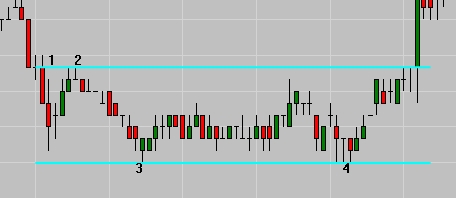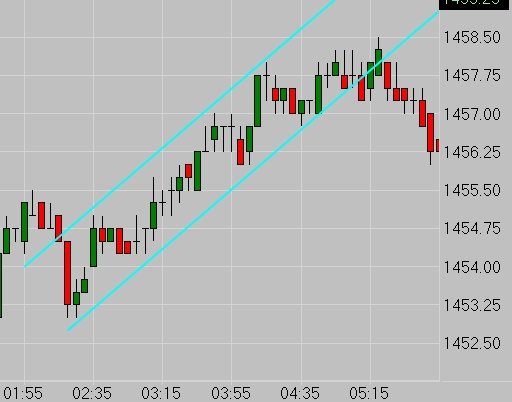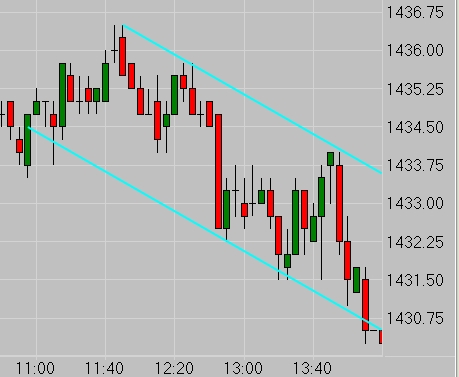Trading Price Channels is a dynamic yet easy to learn form of trading that relies on the markets natural tendency to trend. It is a type of technical analysis that provides ideal areas from which to buy and sell. Price Channels also show you where to put your stop-loss and where to take your profit. Here are a few of the best ways to take advantage of information the market freely gives you.
In technical analysis, a Price Channel is defined by two parallel trend lines. The upper trend line connects price highs and the lower trend line connects price lows. Here are examples of 3 types of Price Channels.
Flat – Ascending – Descending

Current Ascending Price Channel in the S&P 500 Emini Futures
Getting Started
To create a Price Channel follow these easy steps:
- Find a swing high or swing low to start the channel.
- Find another swing high or low and connect the tops or bottoms.
- Copy and paste the trend line you’ve just drawn.
- Grab the parallel trend line and drag it to the top or bottom of price.
There are 3 types of channels you will create as shown in the first diagram.
Bull or Ascending channel — higher high and higher low.
Bear or Descending channel — lower low and lower high.
Flat or Horizontal channel — horizontal highs and lows.
The channel is created by price moving between the upper and lower trend line. The upper trend line represents resistance and the lower trend line shows support. Price channels with upward slopes are considered bullish and those with downward slopes are considered bearish.
In a bullish price channel the primary trade is to buy when price reaches the main trend line support. In a bearish price channel the primary trade is to sell when price reaches the main trend line resistance. Other forms of technical analysis can and should be used to confirm signals.
Trend Line: It takes at least two points of support or resistance to draw the primary trend line. In a bullish price channel, the main trend line extends up and at least two swing lows are required to draw it. For a bearish price channel, the primary trend line points down and at least two swing highs are required to draw it.
Channel Line: The line drawn parallel to the primary trend line is called the channel line. The channel line represents support in a bearish price channel and shows resistance in a bullish price channel. Once the primary trend line is established you only require 1 swing high or swing low to create the channel. However, until you have the second confirming swing high or swing low it is still a work in progress.
Bull Channel: As long as price continues to advance between the primary trend line and the parrallel channel line, you have a bullish trend. The initial warning for a trend change happens when price falls short of channel line resistance and/or a white candle is painted using the CF_TC Trend Change Indicator. If price breaks below the primary trend line and holds on a pull back, the bullish channel is no longer valid. If price breaks above channel line resistance and holds on a pull back, this is a very bullish indication and will increase the width of the channel. Once you have a new swing high in place you simply drag your parallel of the primary trend line to accommodate the new high.
Bear Channel: As long as price declines and trades between the primary trend line and the channel line, the trend remains bearish. The initial signal for a potential trend change happens when price fails to reach support at the channel line and/or a white candle is painted by the CF_TC Indicator. If price breaks above the primary trend line and holds on a pullback, the bear channel is no longer valid. A break below the channel line that holds on a pullback is bearish and indicates an increase in momentum. You will need to drag the channel line lower to the new swing low pivot as the channel itself now has greater range.
Basic Rules for Channel Trading
- In a bull channel you will buy at/or near the primary trend line.
- When price reaches the top of a bull channel sell your long position and/or short the market.
- In a bear channel you will sell at/or near the primary trend line.
- When price reaches the bottom of a bear channel cover your short and/or go long the market.
- When the price is in the middle of the channel, sit tight.
- Do not enter a position in the middle of the channel unless you have some other form of technical analysis that gives you a clearly defined and well confirmed entry.
- When price hits the bottom of a bull channel, you may add to your long position or prepare to exit the market.
- When price hits the top of a bear channel, you may add to your short position or prepare to exit the market.
- If price stalls for a prolonged period of time you may elect to narrow the channel or switch to a flat channel if one is readily visible until the initial trend resumes or changes.
Any trades are educational examples only. They do not include commissions and fees.
Flat Channel

Ascending or Bull Channel

Descending or Bear Channel

Price Channels also assist in establishing both your stop-loss as well as your target.
- If you bought the bottom of a bull channel you will look to take profit at the top of the channel. Your stop-loss will be just below the bottom of the channel, allowing room for regular volatility. Check the ATR for the time frame you are trading and take that into consideration as well.
- If you sold the top of a bear channel you will look to take profit at the bottom of the channel. Your stop-loss will be just above the top of the channel while allowing for regular volatility. Check the ATR for the time frame you are trading and take that into consideration as well.
